It’s a great time to be a Marvel fan: Age of Ultron in theaters, Daredevil on Netflix, Agents of S.H.I.E.L.D. on TV, and a slew of other films coming soon (like Ant Man and Fantastic Four). But if that’s not enough, there’s another way to get your Marvel superhero fix: the Legendary tabletop game.
Legendary isn’t new, but there have been several expansions since its release in 2012, with more on the way. I came across it late and so far I have the base game and the Guardians of the Galaxy expansion, which was released last fall. The Secret Wars expansion is expected in June 2015, though details are still slim on exactly which heroes and villains will be included.
At a glance: Legendary is a (mostly) cooperative deck-building game for 1 to 5 players, ages 14 and up, and takes about 45 minutes to play. The retail price on the base game is $59.99, and expansions vary in price. I would say you could play with younger players, particularly those who are familiar with deck-building games, and especially if you play in fully cooperative mode. Since it is set in the Marvel comic book universe, it features a lot of comic book artwork, but nothing too risque or violent.
Components:
The base game includes a game board and 500 cards. You can see a detailed list here on BoardGameGeek, but briefly:
- 60 starting cards (Agents and Troopers)
- 30 S.H.I.E.L.D. Officers
- 15 Hero decks (14 cards each)
- 4 Masterminds (5 cards each)
- 7 Villain Groups (8 cards each)
- 4 Henchman Villain Groups (10 cards each)
- 8 Scheme cards
- 11 Scheme Twist cards
- 5 Master Strike cards
- 30 Bystander cards
- 30 Wound cards
- 60 Divider cards
The heroes in the base set are: Black Widow, Captain America, Cyclops, Deadpool, Emma Frost, Gambit, Hawkeye, Hulk, Iron Man, Nick Fury, Rogue, Spider-Man, Storm, Thor, and Wolverine. The Masterminds are Dr. Doom, Loki, Magneto, and Red Skull.

The Guardians of the Galaxy expansion is one of the small-box expansions, and includes:
- 5 Hero decks (14 cards each): Drax the Destroyer, Gamora, Groot, Rocket Raccoon, Star-Lord
- 2 Masterminds (5 cards each): Supreme Intelligence of the Kree, Thanos
- 2 Villain Groups (8 cards each): Infinity Gems, Kree Starforce
- 4 Scheme cards
- 18 Shard Tokens (cardboard punch-outs)
I described the cards in my review of Legendary Encounters (the Alien-themed version of the game) and these are the same: they’re glossy cards, very sturdy with a nice snap to them. The artwork on the cards is all Marvel comic book illustrations, so they’re very nice, but can sometimes be a little busy visually. Although it’s nice to have the artwork showcased, the icons and game text is a little small for my taste, and I imagine it wouldn’t be great for somebody with impaired vision. The backs of the cards are pretty boring: just a plain blue background with the Legendary logo.

Also, as with Legendary Encounters, the cards aren’t organized properly when you first open up the shrink wrap. Expect to spend a good deal of time sorting out the cards into their proper decks before the first time you play. There are divider cards, but they aren’t labeled, so you can decide if you want to break out the label gun or write out all the card names yourself.

The board is a pretty large six-fold board, with a huge section for KO’d cards (removed from play) and turn summaries. I like the playmat in Legendary Encounters better, but this serves its purpose just fine, too.
The shard tokens in Guardians of the Galaxy are simple round cardboard punch-outs with numbers on them. However, they’re a little odd, because they have different numbers on each side. So you’ll be flipping them over constantly, trying to figure out how to get the right number of shards and which one of the shards has a “3” on the back. It would have been better, I think, to just have two or three different denominations.
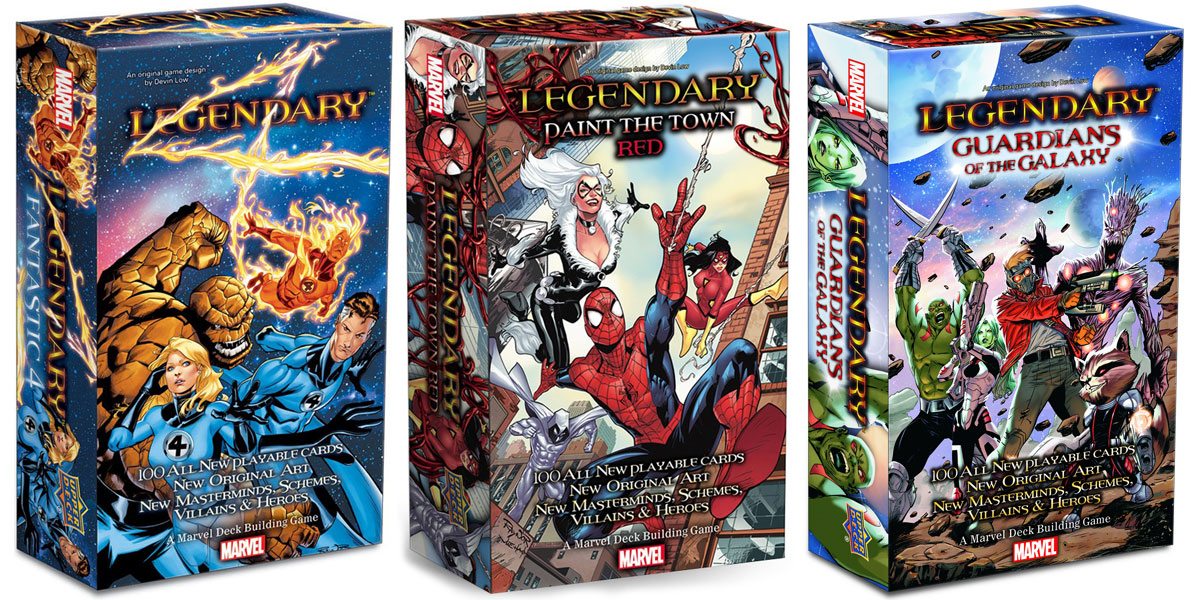
So far, there’s been one big expansion, Dark City, with 17 heroes, 5 masterminds, 6 Villain Groups, 2 Henchmen Villain Groups, and 8 schemes. The other expansions have been more like Guardians of the Galaxy, each with 5 heroes, 2 masterminds, 2 villain groups, and 4 schemes. Fantastic Four includes the four heroes plus the Silver Surfer, with Galactus and the Mole Man as masterminds. Paint the Town Red includes various Spidey allies, with Carnage and Mysterio as masterminds. The upcoming Secret Wars expansion will be another big expansion.
And for those of you who feel a bit more … villainous, there’s a stand-alone game called Legendary: Villains which flips the game upside-down, with players playing as the villains trying to take out the heroes. It has its own small expansion, Fear Itself, but I haven’t played any of the Villains line myself yet.
How to Play
The object of the game is to defeat the Mastermind before he accomplishes his fiendish Scheme. You can play fully cooperative, or semi-cooperative where each player will get points for villains they defeat and bystanders they rescue.

To set up the game, you’ll pick a Mastermind and a Scheme–the Mastermind has 5 cards, one that is placed face-up and indicates the attack strength you need to defeat it, and the others have effects that will take place each time you fight it. You’ll need to defeat the Mastermind four times to win the game. The Mastermind card also tells you what happens whenever a Master Strike card is drawn, and also lists the Villain Group that will always be associated with this Mastermind. For instance, Red Skull always leads HYDRA.
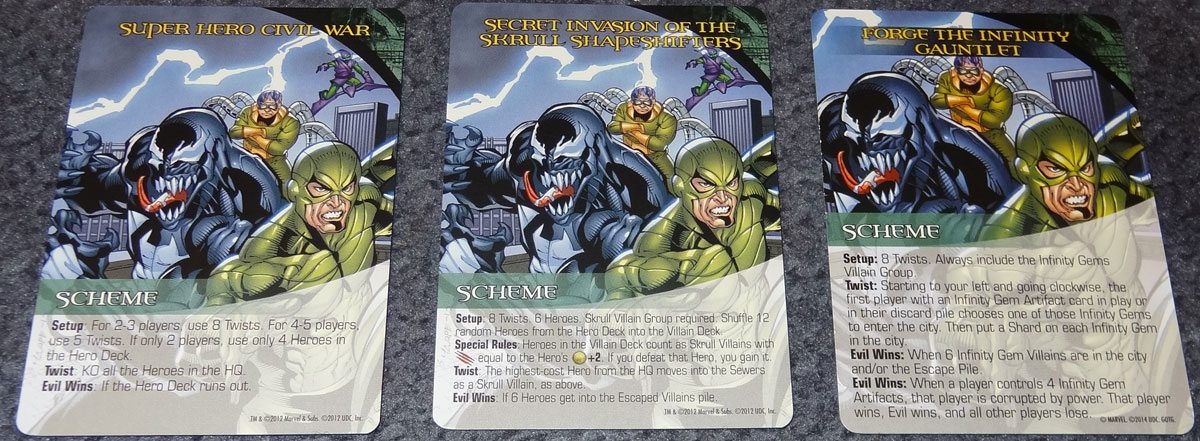
The Scheme card, placed in its spot on the board, indicates what the Mastermind is trying to do, and also gives a few rules about setup and Scheme Twist cards. The Scheme Twist cards will be shuffled into the Villain Deck, and each time one is revealed, the Scheme card tells you what its effect is.
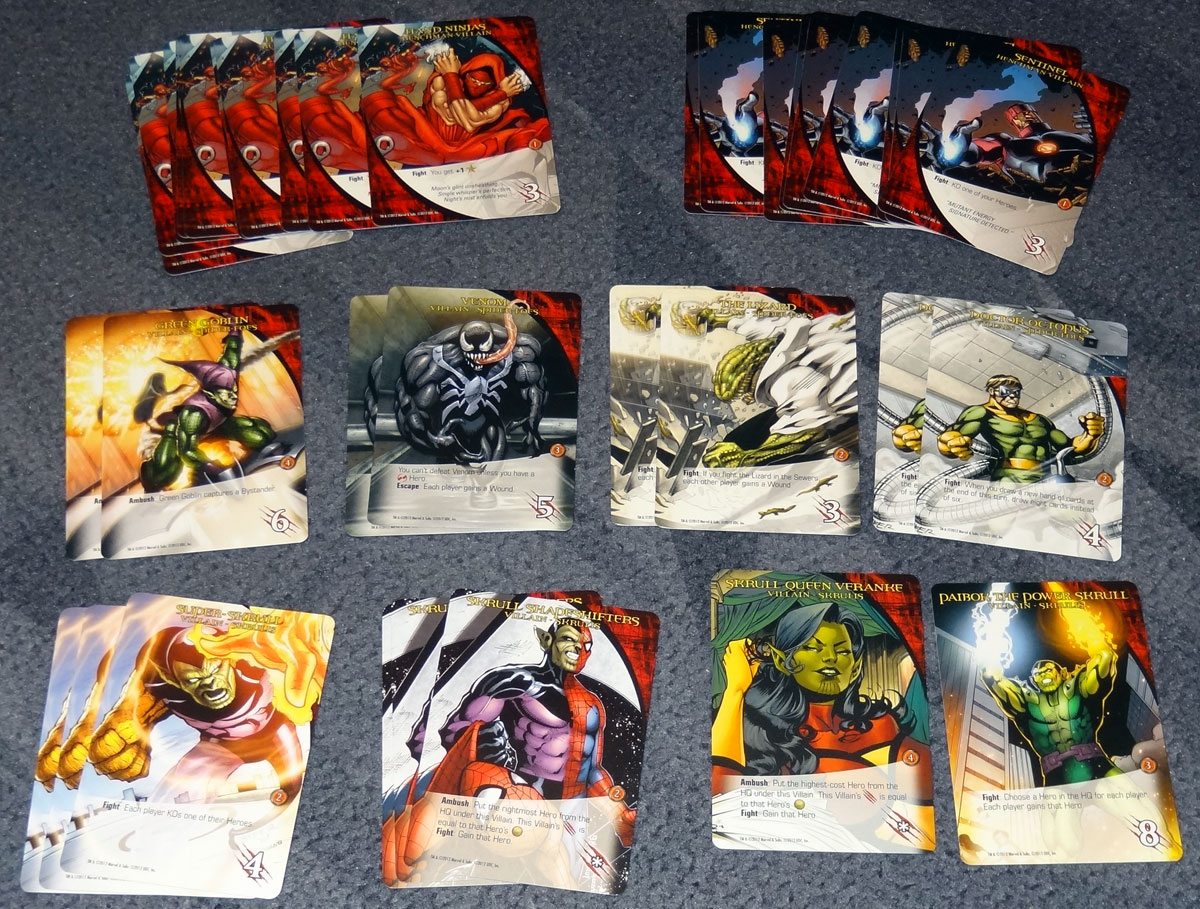
You’ll create the Villain Deck based on the number of players, with the Scheme Twists, 5 Master Strike cards, and some number of Villain Groups, Henchmen Groups, and Bystanders. The Villain Deck is shuffled and placed in its spot on the board.
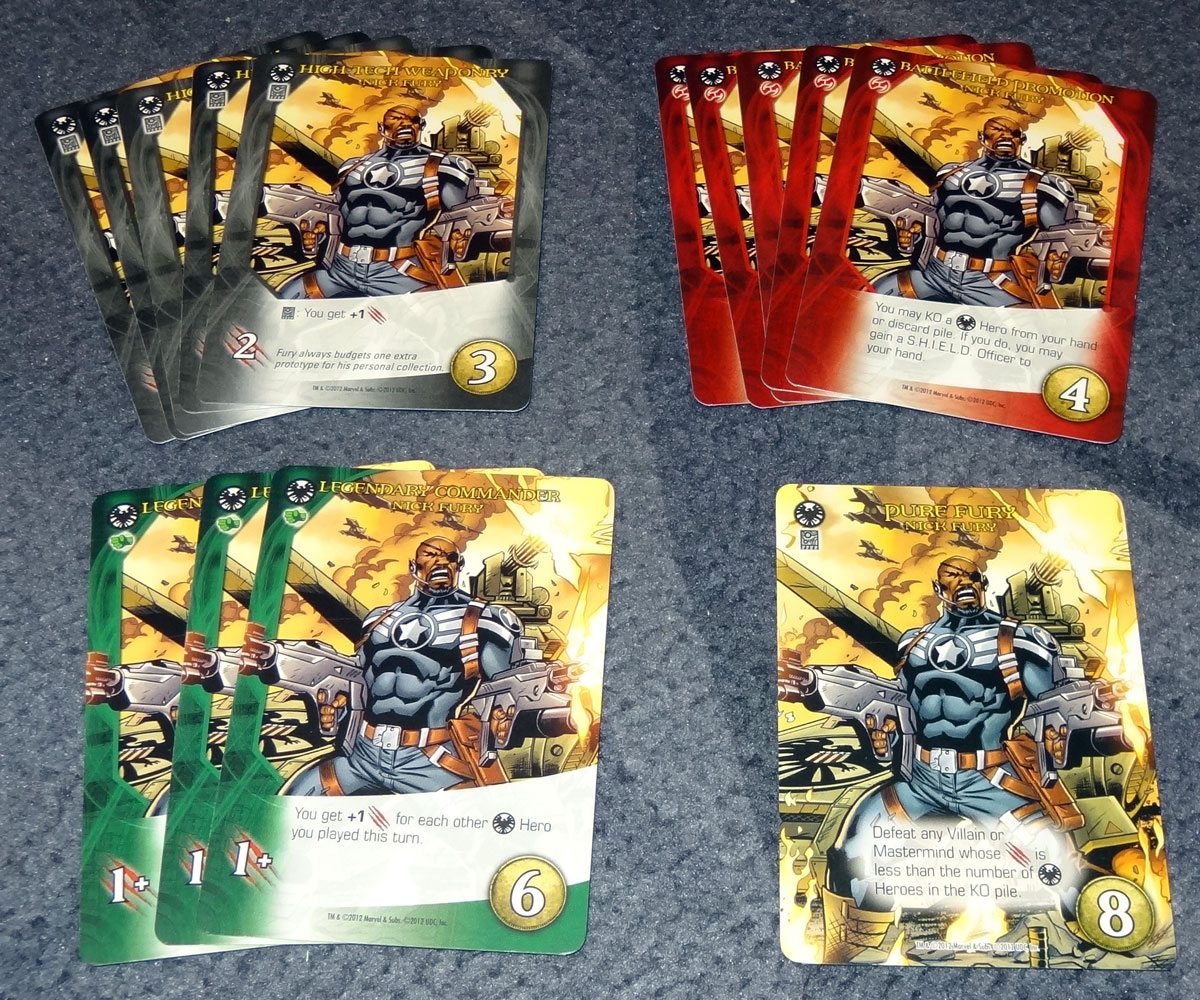
Next, you’ll create the Hero Deck: pick 5 heroes (or 6 if you’re playing with 5 players), and take out their 14-card decks. Shuffle them all together, and place this Hero Deck on its spot. Then flip over the first five Hero cards into the HQ spaces on the board. Any time there is an empty space in the HQ, a new card is immediately drawn from the Hero Deck to replace it.
Finally, there are some stacks that are just placed on the board in their appropriate locations: the rest of the Bystanders, Wounds, and S.H.I.E.L.D. Officers.
Each player gets a starting deck of 8 S.H.I.E.L.D. Agents and 4 S.H.I.E.L.D. Troopers. Everyone shuffles their own deck and draws 6 cards.
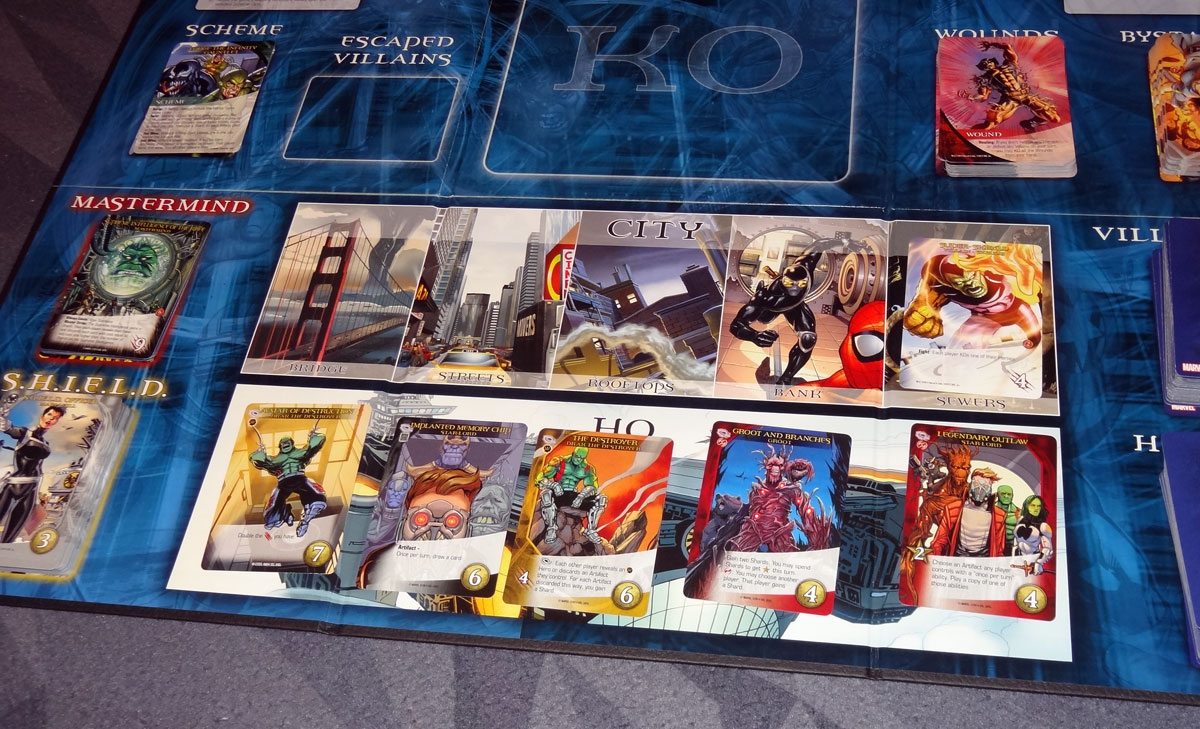
On your turn, you do the following:
- Play the top card of the Villain Deck.
- Play cards from your hand to recruit and fight.
- Discard the rest of your hand and draw 6 more cards.
Legendary is a deck-building game, so each player has a draw pile, hand, discard pile, and scoring pile. Over the course of the game, you’ll acquire more cards into your discard pile, and if your draw pile ever runs out you shuffle the discard pile and form a new draw pile.
Play the top card of the Villian Deck: Flip over the top card of the deck. Most of the cards are Villains of some sort, and they go into the City spaces. There are five City spaces, and you place the Villain in the nearest spot (the Sewers), bumping any existing cards over if necessary to make room. Some Villains have “Ambush” effects, which will take place when they are revealed.
If a Villain gets pushed off the last space, the Bridge, then it goes into the Escaped Villains pile. The escaped Villain KO’s a Hero from the HQ–that means it’s removed and put into the big KO space on the board, out for the rest of the game. If the Villain had any Bystanders, then each player must discard a card as a penalty. Finally, if the Villain had any “Escape” effect, you resolve that.
If the card is a Bystander, then the nearest Villain has captured it–you place it under the Villain card. Defeating that Villain will free the Bystander (which is worth 1 point when rescued).
If the card is a Scheme Twist, consult the Scheme card to see what it does. If it’s a Master Strike, consult the Mastermind card to see its effect.
Play cards from your hand: You may play any or all of the cards from your hand, and the order matters. Some cards have stars or red scratches on the left side–these are Recruit points and Attack points, respectively. The total number of Recruit points you accumulate during your turn may be used to acquire new cards from the HQ (or the S.H.I.E.L.D. Officer pile), according to the cost shown in the gold coin in the bottom corner. The total number of Attack points you accumulate may be spent to attack Villains in the city or the Mastermind. You may recruit and attack multiple cards, in any order, as long as you have enough to spend.
Some cards have effects–you take these effects as you play the cards. Others have superpower abilities, indicated by a small icon before the effect. To use a superpower ability, you must have played another card with that icon in the top left already. So it’s a good idea, when buying new cards, to remember which superpower abilities you have, and buy more cards with the required icons so you have a better chance of using those abilities.
If you recruit a card, place it into your discard pile. If you defeat an enemy, you resolve the “Fight” effect listed on that Villain, if any, and place the Villain in your scoring pile. If you fight the Mastermind, you take one of the face-down Mastermind Tactics cards and resolve its effect.
Discard and draw: Finally, once you’re done with your turn, discard all of the cards you played this turn, and any cards left in your hand. Draw a new hand of 6 cards.
The game may end in a few ways:
- The Mastermind has been defeated four times (using up all the Mastermind Tactics cards) and the players win.
- The Mastermind completes the Scheme, and the players lose.
- The Villain Deck or Hero Deck runs out–the game ends in a draw.
If you’re playing semi-cooperatively, then each player adds up the points on cards in their scoring piles, and the highest score wins. There’s also an optional rule for a Final Showdown–each player gets one last turn to generate as many Attack and Recruit points as they can. Whoever has the highest total takes the Mastermind card, which will be worth extra points.
The Guardians of the Galaxy expansion adds “shard” tokens–these can be gained by players, Villains, and Masterminds. Players may spend them to increase Attack, and typically Villains and Masterminds become stronger when they have shards. Also, When Villains with shards escape, the Mastermind gets a shard. When Villains or Masterminds with shards are defeated, the player gets a shard.
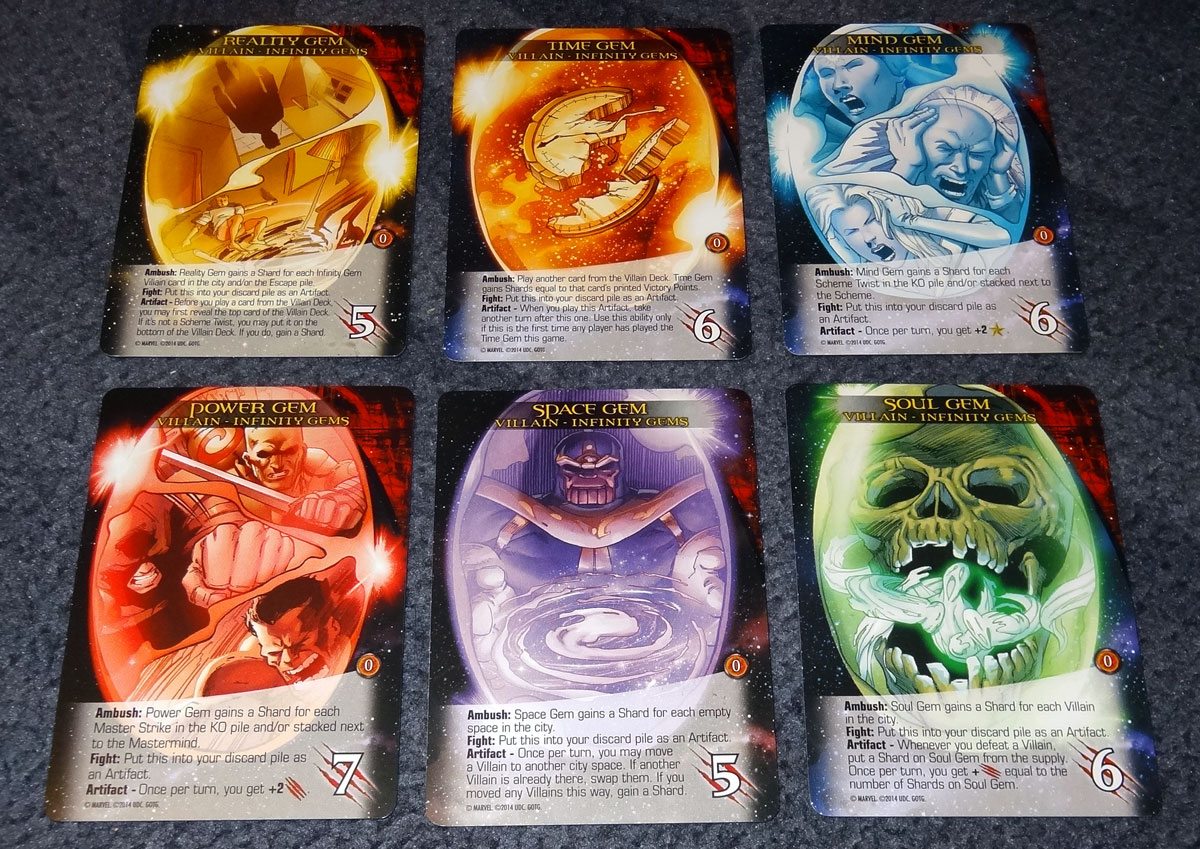
Also new are Artifact cards–some of the Hero cards are Artifacts. When these are played, they are placed in front of the player and remain in play, giving some effect or ability until something causes it to be discarded. The Infinity Gems Villain Group is interesting, because they act as Villains while in the city, but when you defeat one, you gain it into your discard pile as an Artifact.
The Verdict
Deck-building is one of my favorite mechanics–I know there are people who don’t care for it, but I like the way you start with a basic set of cards and build up an “engine” as you go. And I love cooperative games, too–in this case, it allows people to focus on different things and build different types of engines. Legendary is a great mix of the two, and the fact that it takes place in the Marvel comic book universe is just icing on the cake.
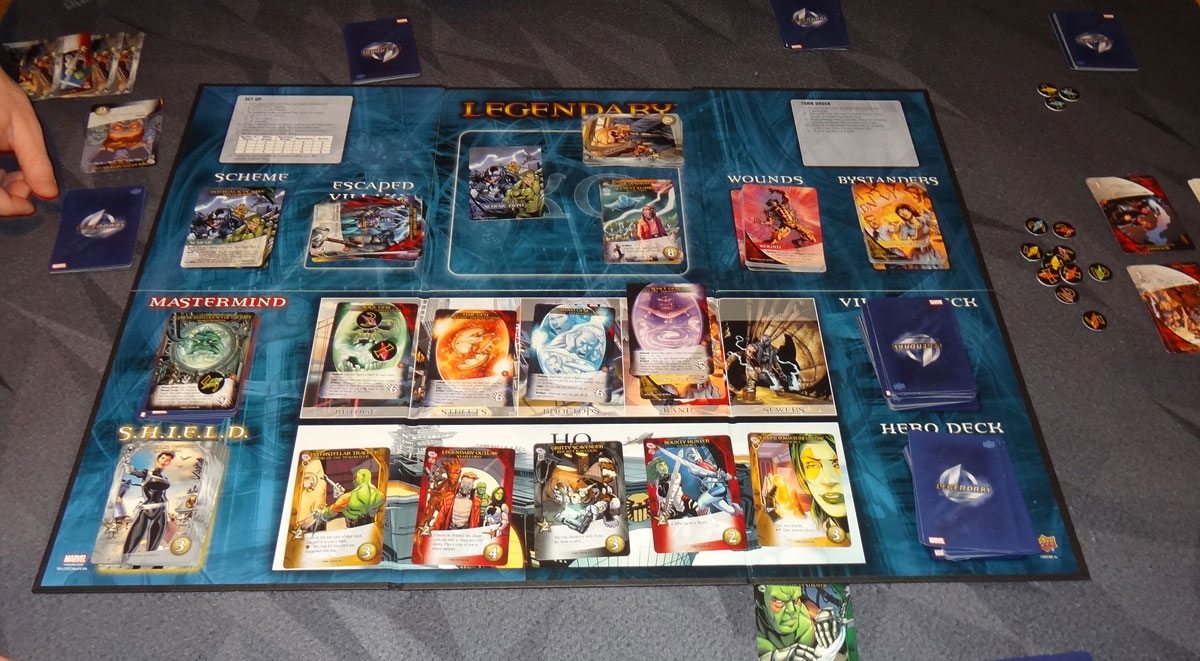
Thematically, the game works really well. The idea is that, rather than being a superhero yourself, you are leading a team of superheros and S.H.I.E.L.D. agents into battle. Today you might have Spider-Man and Wolverine with you; the next day another player may take Wolverine and Captain America on a mission. (This contrasts with the DC Comics Deck-Building Game, which, while it may be easier to learn as a deck-building game, doesn’t always make sense because you play as a superhero but you can acquire powers belonging to other heroes.)
I like the cooperative aspect, and generally I play fully cooperative without tracking individual scores. If you do play semi-cooperatively, it makes players more selfish about which villains they attack or which heroes they recruit–and this in turn can sometimes make it harder to defeat the Mastermind. But it can be fun either way.
There are a few weak points mentioned in my review of Legendary Encounters that apply here as well: first, that the cards can be a little hard to read. The text is small, the icons are tiny, and the backgrounds and borders can be really busy. Also, having to collate all the cards manually the first time you play is a big headache. At least in the Marvel version, the cards are relatively easy to sort into their respective piles at the end of the game.
Often, when I’ve played Legendary, it can feel like the Villains will overrun the city, but if you manage to build up your decks well, at some point you get over the “hump” and things start getting easier. The players reach a point where getting enough Attack points to defeat the Mastermind happens often, and then the game concludes pretty quickly. Granted, you may not win the game every time. But when you do win, it often feels like the last few fights are easy, rather than a huge final fight you may not survive. After all, in Legendary, you don’t fight an enemy at all unless you have enough Attack power.
This version is also easier than the Alien-themed game, in my opinion. Although the mix of Mastermind, Scheme, and Villains can change each time you play, the objective doesn’t: defeat the Mastermind four times. And while the Scheme Twists can have increasingly powerful effects, the rest of the Villain Deck is pretty uniform throughout. That contrasts with Legendary Encounters, in which you have three separate objectives that must be accomplished, and the Hive Deck has three layers to it corresponding to those different objectives.
Of course, there are a lot of easy ways to tweak the difficulty level, as the rulebook explains, so you can always make adjustments to get something you like. And the expansions do mix things up a bit, too. For instance, Thanos, a Mastermind in the Guardians of the Galaxy expansion, requires 24 Attack to defeat–plus even more if he has shards. That’s a huge contrast to Red Skull, who can be defeated with 8 Attack.
One of the really fun parts of playing Legendary is picking the starting setup. The base set will give you several X-Men and Avengers options–you can pretend you’re in the first movie and pick a fight with Loki. Once you’ve got the Guardians of the Galaxy set, you can play that movie as well (though Ronan is in this case one of the Kree Starforce Villains and not the Mastermind). And, of course, you can mix X-Men with Avengers with Spider-Man without any sort of studio licensing issues.
Overall, I’ve really enjoyed Legendary and will most likely add the other expansions to my set as I’m able to. I’ll be watching for the Secret Wars set to see what’s included. If you’re looking for a fun way to dive into the Marvel comic book universe, give Legendary a try. Start with the base set, and then add in your favorites as you go.
Disclosure: I received a review copy of the Guardians of the Galaxy expansion.
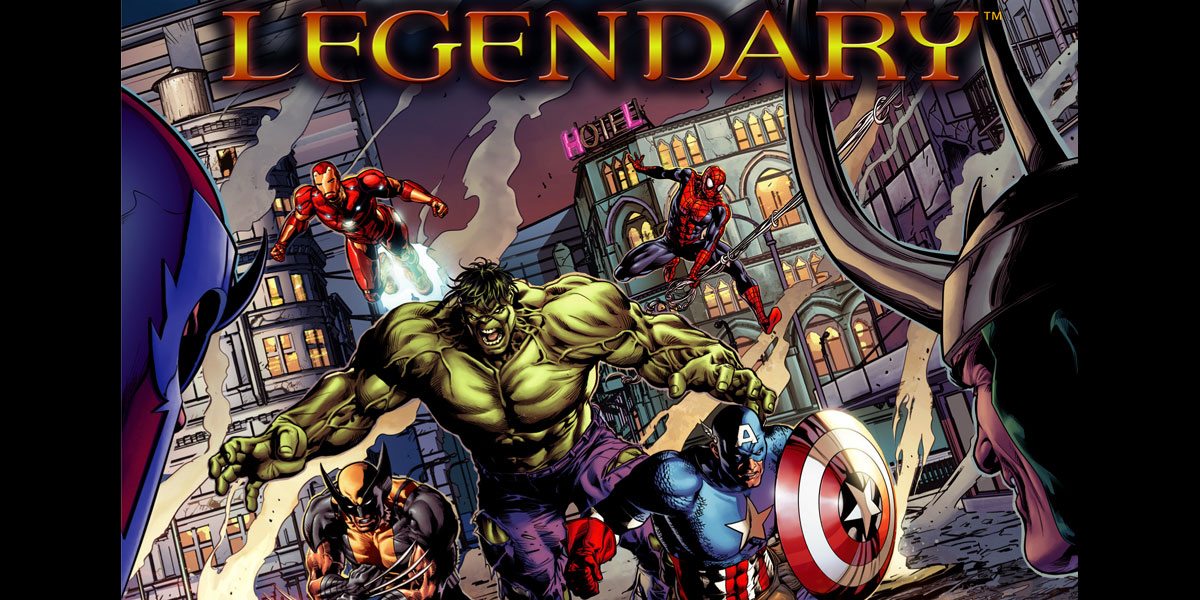
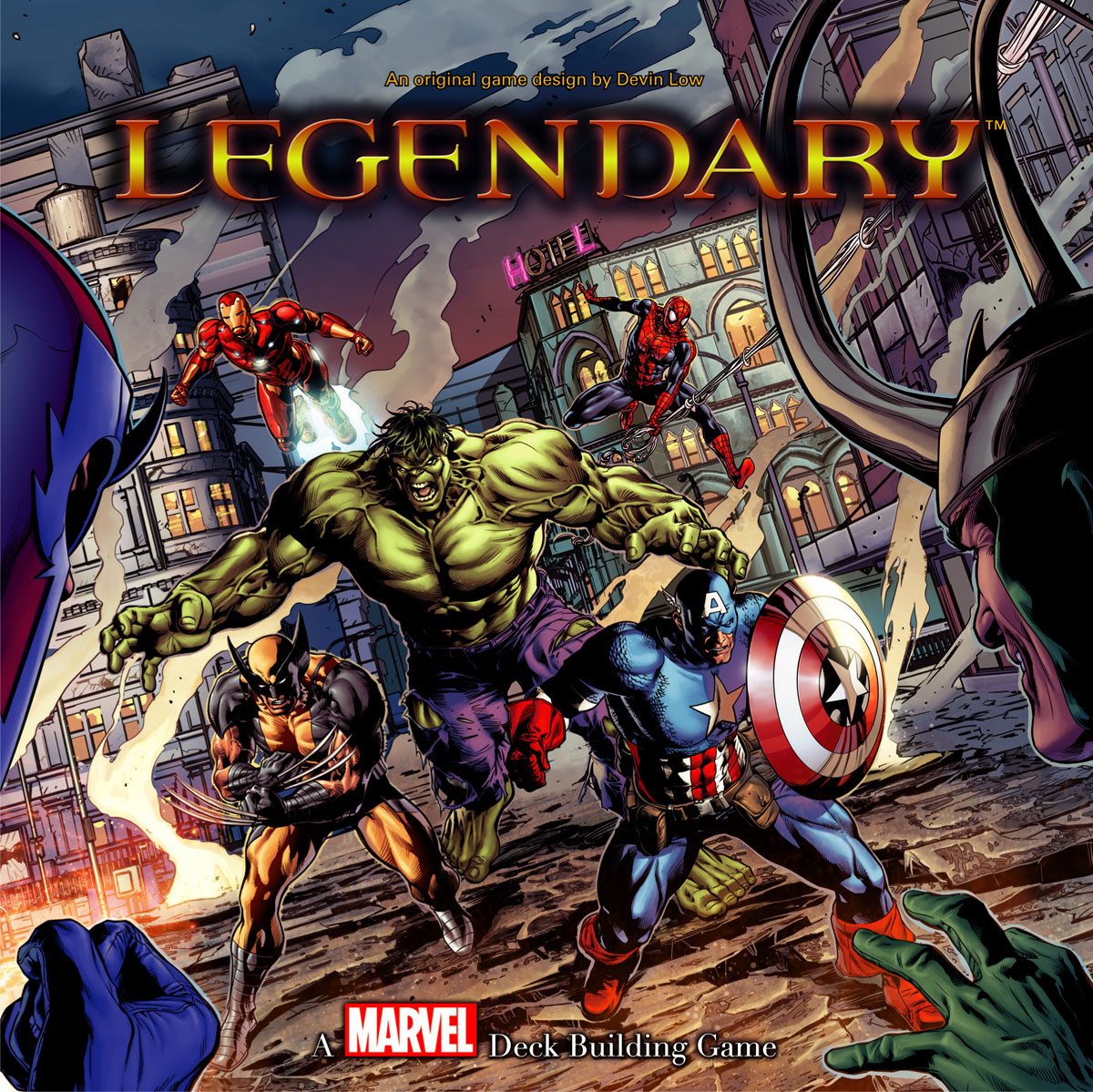




Thanks for the review. I have had this game and its expansions in my Amazon “saved for later” cart while I debate whether I should buy it. Your review really helped since the publisher’s info is nearly useless. As it is, I think I’ll need to hold off purchasing it for another year or so until my son’s reading ability improves, but great (if complicated) explanation!
You’re welcome! I would say that the DC Comics game is easier to learn and play, mechanically, but the theme never quite clicked for me. Legendary seems to mesh better thematically, with each hero’s deck of cards somehow pertaining to their abilities.